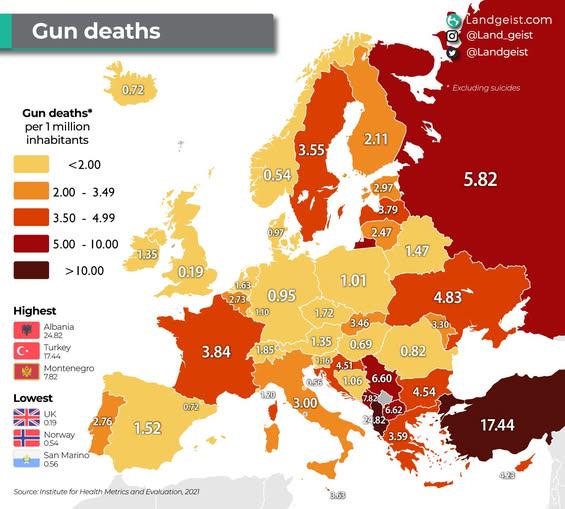Gun Deaths by Country in Europe Map


Marcus Rodriguez
Historical Geography Expert
Marcus Rodriguez specializes in historical cartography and geographic data analysis. With a background in both history and geography, he brings unique...
Geographic Analysis
What This Map Shows
The visualization titled "Gun Deaths by Country in Europe Map" presents a stark representation of firearm-related fatalities across various European nations. It utilizes color coding to reflect the number of gun deaths per 100,000 people, allowing viewers to quickly grasp how different countries compare in terms of gun violence. This map does not merely serve as a visual tool; it provides a critical lens through which we can examine the complex issues surrounding gun violence in Europe.
Transitioning from the visualization, let's delve deeper into the topic of gun deaths, exploring the underlying factors, statistics, and the broader implications of these tragic occurrences.
Deep Dive into Gun Deaths in Europe
Gun violence is a pressing issue that varies immensely across Europe, influenced by cultural, political, and legal factors. Interestingly, while Europe is generally viewed as a region with lower rates of gun violence compared to other continents, the disparities between countries are significant. For instance, countries like Switzerland and Finland have relatively high rates of gun ownership, yet they experience lower rates of gun deaths compared to nations like Sweden or the UK, where strict gun control laws are in place.
According to recent data, the overall gun death rate in Europe is about 1.6 per 100,000 people, but this figure masks substantial differences. In countries like Serbia and Montenegro, the rates soar to levels comparable to some of the most gun-violent places in the world, with Serbia reporting about 10.7 gun deaths per 100,000 people. This raises the question—what drives these discrepancies?
One key factor is the legal framework surrounding firearm ownership. Countries with stringent regulations, such as the UK and Germany, have seen dramatic declines in gun deaths over the years. In the UK, for instance, the introduction of the Firearms (Amendment) Act in 1997 effectively banned private ownership of handguns, leading to a notable drop in gun-related homicides. In contrast, nations like the Czech Republic, where gun ownership laws are more permissive, see a different relationship between gun ownership and gun violence.
Furthermore, socio-economic factors play a significant role. Countries with higher levels of poverty, unemployment, and social unrest tend to experience higher rates of gun violence. For example, in regions grappling with economic difficulties or political instability, such as parts of Eastern Europe, gun deaths can spike, reflecting broader societal issues.
Another critical aspect is the influence of organized crime. Countries with significant organized crime presence, like Italy and Spain, often see higher rates of gun violence, which is frequently tied to gang-related activities. In these contexts, firearms become tools of power struggles, leading to escalated violence and higher mortality rates.
Regional Analysis
When we analyze the map, several regional trends emerge. Northern European countries, such as Norway and Denmark, display some of the lowest gun death rates in the continent, often attributed to their strong social welfare systems and comprehensive gun control measures. In contrast, Southern and Eastern Europe show higher rates, with countries like Serbia and Albania facing challenges related to post-conflict legacies and the proliferation of illegal firearms.
For instance, in the Balkans, the aftermath of civil conflicts has left a legacy of widespread gun ownership, with many citizens possessing weapons from the wars of the 1990s. This historical context helps explain the elevated rates of gun deaths in these regions compared to their Western counterparts.
On the other hand, Western Europe, including nations like France and Germany, has seen a steady decline in gun deaths over the past few decades. This decline can be attributed largely to proactive policies aimed at reducing gun violence, alongside public health campaigns that address the roots of violence.
Interestingly, the map reveals the impact of recent political changes on gun violence. For example, the rise of populism and anti-immigration sentiments in certain countries has often led to a spike in hate crimes, some of which involve firearms, showcasing how political climates can directly influence gun violence trends.
Significance and Impact
Understanding the landscape of gun deaths in Europe is crucial for policymakers and citizens alike. The implications of gun violence extend far beyond the immediate loss of life; they affect community safety, public health, and perceptions of security. What's fascinating is that while Europe, as a whole, is safer than many parts of the world, the differences between countries can serve as a roadmap for others to follow.
Current trends indicate that while countries with strict gun control are likely to maintain lower gun death rates, the challenge remains in addressing the socio-economic and cultural factors that contribute to violence. As we observe shifts in political climates and societal attitudes towards firearms, it's vital that European nations share insights and strategies to combat this issue collectively.
Looking ahead, projections suggest that countries will need to adapt their policies to reflect changing social dynamics and the evolving landscape of gun ownership. As we continue to monitor these trends, it’s evident that the path forward requires a nuanced understanding of both the data and the human stories behind the numbers. Gun violence is not just a statistic; it represents lives lost, families affected, and communities striving for safety and peace.
Visualization Details
- Published
- October 17, 2025
- Views
- 8
Comments
Loading comments...